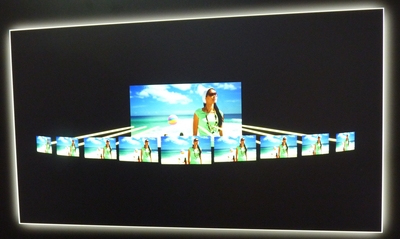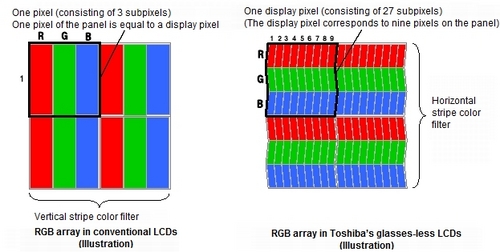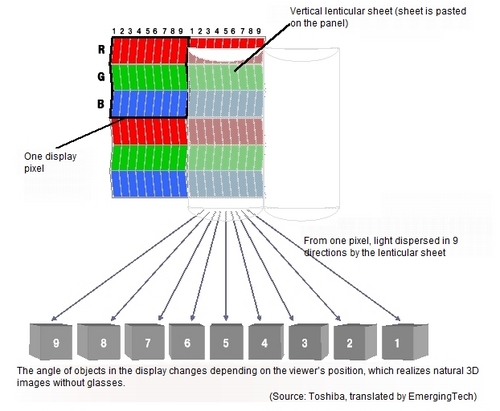Toshiba Corp. has developed 3D LCD TVs based on an integral
imaging method that presents the 3D effect to viewers without the need
for special glasses by combining the computing power of the CELL engine
and newly developed 4Kx2K low-temperature polysilicon (LTPS) displays.
This advance follows Toshiba's commercialization of conventional 3D TVs
requiring glasses. "Since ideally we want to offer 3D TVs that deliver
3D images to viewers without glasses, we deployed our technologies to
make it happen," said Masaaki Oosumi, president and CEO of Toshiba
Visual Products Company.
 Toshiba's glasses-less 3D TV generates 9 parallax images
Toshiba's glasses-less 3D TV generates 9 parallax images
from one original frame to create the 3D effect.
Toshiba will begin marketing two 3D TVs—a 12-inch and a 20-inch model,
in Japan in December. The company is also currently exhibiting a
prototype 56-inch 3D TV at the CEATEC show in Makuhari.
Toshiba will probably begin releasing products overseas once 40-inch
or larger TVs employing the integral imaging method are ready, said
Oosumi.
Whereas current 3D TVs deliver the 3D effect by sending two images
for the left and right eyes, respectively, the integral 3D system
creates the 3D effect by delivering multiple images with different
angles. Toshiba's TVs generate nine parallax images from one original
frame.
In Japan, NHK and Hitachi are also developing a 3D system based on
the integral method. The biggest challenge is to attain high resolution.
Toshiba realized HD resolution (1280x720 pixels) for the 20-inch TV,
dubbed the 20GL1. The company attributes this to a new engine and a
low-temperature LCD jointly developed with its subsidiary Toshiba Mobile
Display, a specialist in LTPS displays.
To achieve a glasses-less performance, the dedicated 3D engine
integrates the Cell Broadband Engine and the multi-parallax conversion
LSIs for image processing.


The LTPS display has 4Kx2K (8,294,400 pixels) resolution. Each pixel
consits of vertically aligned red, green and blue subpixels. Nine pixels
in a set function as one virtual pixel for the 3D display. Nine
parallax lights from one pixel are dispersed by a lenticular sheet on
the display.
The company plans to sell the 20-inch TV at about 240,000 yen
(US$2800*) and the 12-inch one at around 120,000 yen. It expects to ship
about 1,000 sets a month.
* Original figures are in Japanese yen. The exchange rate is roughly US$1=85 yen.
Toshiba has taken the lead in the introduction of glasses-less 3D
TVs, but marketing appears to be almost on a trial basis—limited to
Japan and with monthly shipments of only 1,000 units. Oosumi of Toshiba
Visual Products conceded that the products are rather
technology-oriented and not yet fully optimized in terms of cost and
size.
Meanwhile, powerful competitors in Korea are also readying
glasses-less 3D TVs. It was reported in June that a concerted
government-industry effort is being launched in Korea, including
subsidies, to promote the development of glasses-less large-sized 3D TVs
and 3D cameras, targeting completion of display development in 2012 and
of camera development in 2013.

Review: Toshiba’s glasses-free 3D TVs
Toshiba
is the first mayor brand to actually release 3D TVs which do not
require glasses. Here we take a look at these TVs and try to decide
whether you should already consider buying these TVs or if it’s better
to wait or maybe you should stick to 3D TV with glasses.
The
technology being used here works by providing two different
perspectives of one two dimensional picture. A barrier or lens makes
sure your right eye receives only one of the two perspectives and your
left eye the other. Your brain then combines the two perspectives into a
three dimensional picture.
The following glasses-free 3D TV models are already available on the market.
In October 2010 Toshiba unveiled the first 3D TV models requiring no glasses:
| Model | Screen size | Resolution | Price |
|---|
| Toshiba Regza 20GL1 | 20 inch | 1280×720 | $2900 (just in Japan) |
| Toshiba Regza 12GL1 | 12 inch | 466×350 | $1400 (just in Japan) |

- Parallax barrier and lenticular screen technology (Source: Wikipedia)
It
is a benefit that you can actually see a sharp three dimensional
picture without having to wear any special 3D glasses with these TVs.
Since there are no glasses to determine which picture should be
received by which eye, other technology is needed. In the models
currently available two technologies called Lenticular Lens
Technologyand Parallax Barrier Technology are used. This is also known
as auto stereoscopy.
It works by providing two different
perspectives of one two dimensional picture. A barrier or lens makes
sure your right eye receives only one of the two perspectives and your
left eye the other. Your brain then combines the two perspectives into a
three dimensional picture.
Currently
there are some major drawbacks to these TVs. Due to using a combination
of the Lenticular Lens Technology and the Parallax Barrier Technology,
the picture can only be shown on a smaller screen.
A couple of the
other current limitations include a very limited viewing angle of
approximately 40 degrees and the need for the views to sit at a fixed
distance for a sharp picture. This distance is about 2 feet for a 12
inch TV and 3 feet for the 20 inch TV.
Even
if you are able to get all of these things right you still will not get
the same effect as you would with glasses. You will not be able to see
any bullets flying by or any dinosaurs leaping off the screen without
using glasses.
Currently these models are only available in Japan.
In December 2011 Toshiba is about to release the following TV:
| Model | Screen size | Resolution | Price |
|---|
| Toshiba Regza 55X3 (former 55ZL2) | 55 inch | 3840×2160 | $11730 (Japan, December 2011, availability outside of Japan unknown) |
This
glasses-free model uses the same technology as the previously mentioned
TVs, but with a few tricks. Toshiba managed to get the effect on a
screen size of a whopping 55 inches, which is a huge improvement over 12
and 20 inches.
This is accomplished partially by a technology
called the Head Tracking 3D Technology. This Technology consists of a
camera that determines the different viewer positions, and enables
everyone to get the same 3D effect by sending two slightly different
pictures to the respective left and right eyes of each individual
viewer.
This may save some of the problems previously mentioned.
However, one negative is that the perceived 3D effect only seems to go
in depth and not very much. So there won’t be anything flying out of
your TV.
Toshiba plans on continuing their line of 3D TVs without glasses and delivering glasses-free 3D TV worldwide by 2015.
FILED UNDER
Are you currently frustrated putting on three dimensional glasses if you watch
three dimensional movies and playing games?
For those individuals who say yes for above question this is a new
technology where individuals four eye watching could be prevented.
Manufacturers and Toshiba ‘re going allow it to be alive with glasses-free 3-D to portable products.
Superbly
animated figures appear to become jumping from the overall game player
I’m holding. Planes and cars are swooping toward me so well which i’m
really flinching. The graphics are detailed the colours are natural.
I’ve didn’t have a much better 3-D experience, and here’s the good
thing: This handheld, multidimensional marvel, a prototype from 3M,
doesn’t require me to put on individuals cumbersome, chunky 3-D
eyeglasses.
New glasses-free 3-D products are going to hit the industry, as well
as their backers are wishing they’ll make three dimensional glasses as
obsolete as Smell-O-Vision. These devices, referred to as “autostereo”
to differentiate them in the kind needing eyeglasses, includes not just
video games such as the one I’ve been having fun with but additionally
cameras, mobile phones, and tablet computer systems. One of the primary
is going to be autostereo 3-D Televisions, at the moment striking stores
in Japan, and
Manufacturers’s 3DS handheld gaming system, due for release worldwide early the coming year.

PRINCIPLE OF three dimensional DISPLAY:
To see 3d, an individual’s eyes must see different, slightly
unaligned images. Within the real life, the spacing between your eyes
makes which happen naturally. On the video screen, it’s not too simple
one display in some way needs to present another and separate view to
every eye. Some systems handle this concern by interspersing the right
and left sights they’re known as multiplexed. Others, known as
consecutive, alternate right and left sights. Regardless of the
approach, the shows then use optical or technological methods to direct
the right view towards the correct eye.
For instance, the bulkiest three dimensional glasses combined with
presently available 3-D Televisions are active-shutter glasses. They
contain some miniature LCD sections that synchronize using the large LCD
screen within the TV. Once the primary screen is showing a picture
destined for the right eye, a liquid-very shutter within the left lens
from the glasses makes that lens opaque, and the other way around. This
consecutive system switches between images intended for each eye a large
number of occasions another, developing a smooth 3-D effect.

Principle of Manufacturers and Toshiba for glasses free 3-D technology is :
The Manufacturers 3DS’s autostereo screen,
produced by Sharp,
utilizes a multiplexed “parallax barrier” technology. This process lays
another layer of liquid deposits alongside a conventional LCD and it is
backlight. This extra layer produces thin vertical strips that block a
few of the light and direct the rest of the light alternately towards
the right and left eyes, developing a 3-D effect for any single viewer
in a set distance, usually around 30 centimeters.

Parallax barrier technology comes with a couple of problems. Since
the multiple layers of deposits prevent some light from reaching the
consumer, dealing with a suitable degree of brightness means turning in
the backlight, drawing up energy and rapidly draining batteries in
portable products. And since each eye sees only half a screen’s total
pixels, the strategy cuts the effective resolution in two. So producers
must choose from a presentation of normal resolution and brightness—and
suffer dull, low-resolution 3-D graphics—or upgrade to some better,
greater resolution screen that’s also pricey and energy hungry.
Manufacturers split the main difference using its new console,
thumping the brightness up but keeping the resolution relatively low.
The 3DS comes with an 800- by 240-pixel screen that provides 400- by
240-pixel sights to every eye. Although this is one step up in the
256-by-192 screen of their predecessor, the Manufacturers Nintendo dsi,
it is only one-sixth the resolution located on the similarly sized Apple
apple iphone 4. Quite simply, you wouldn’t wish to watch a movie—or
even notice a photo slideshow—on the 3DS.
Parallax barrier shows also provide sensitive geometries that deliver
optimum 3-D effects limited to a specific eye-separation distance—as
close as you possibly can towards the record average of 65 millimeters.
These shows will also be updated for any specific distance from screen
to eye, using the 3-D effect diminishing in the event that distance is
off by less than 5 centimeters. This distance sensitivity is a smaller
amount of an problem for handheld products than free standing shows.
There-forefront we are able to enjoy 3-D without glasses…….Technology Rocks……..